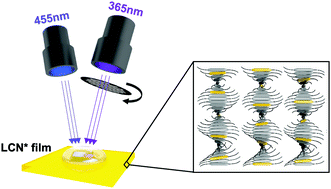Light-regulated molecular diffusion in a liquid crystal network†
Abstract
Photo-responsive liquid crystal polymer networks offer promising means to generate useful functional devices, but many of them focus on their mechanical response so as to generate surface features or shape change. Here, we investigate the photomechanical effect of the polymer network for molecular transport purposes. Dual wavelength illumination of an azobenzene-functionalized cholesteric liquid crystal polymer film produces excess free volume within the film, which results in an accelerated molecular diffusion through the film. Moreover, the polarization of the UV light exposure on the cholesteric network plays an important role in a remarkable enhancement of molecular diffusion. When linearly polarized UV light rotates along with the twist of the helical axis of the cholesteric polymer, excess free volume forms sequentially from the diffusion network toward the dry network in the polymer. It works in concert with the concentration gradient of the diffusant and greatly improves the diffusion through the film.



 Please wait while we load your content...
Please wait while we load your content...